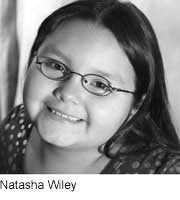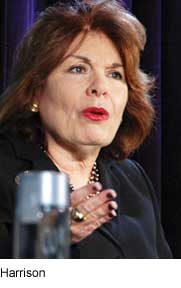My Source replies to taunt of ‘irrelevance’
Originally published in Current, March 24, 2008
By Jeremy Egner
CPB screened My Source testimonials to the value of public broadcasting from Jimmy Carter, Kevin Bacon and sundry other celebrities, but the enthusiasm of some unknown fans may mean the most.
 In a spot produced by WEIU in Charleston, Ill., a bubbly grade schooler’s eyes flickered behind tiny glasses as she gushed about her affection for the PBS Kids show Maya & Miguel.
In a spot produced by WEIU in Charleston, Ill., a bubbly grade schooler’s eyes flickered behind tiny glasses as she gushed about her affection for the PBS Kids show Maya & Miguel.
“My name is Natasha Wiley,” she chirped, “WEIU is my source for PBS Kids.”
A chorus of giggles and “awwwws” echoed through the ballroom full of pubcaster station managers and board leaders at CPB’s second annual National Leaders Meeting March 13 in Chantilly, Va. But behind the real-person appeal is a serious, multimillion-dollar plan to incorporate fans’ endorsements for public TV and radio into a major marketing push.
CPB’s Public Awareness Initiative, with its open-ended My Source tagline, aims to raise the system’s collective profile and charm politicos, decision-makers purse-string holders — and all their acquaintances who vote — by getting its devotees to tell one another, over the air, about what pubcasting has contributed to their lives.
 Pubcasters “don’t really have a chance to brag about what they’re doing, and they need help,” says CPB President Patricia Harrison. “And the help is coming from the people who have benefited and who believe our country has benefited.”
Pubcasters “don’t really have a chance to brag about what they’re doing, and they need help,” says CPB President Patricia Harrison. “And the help is coming from the people who have benefited and who believe our country has benefited.”
At the heart of the project is the My Source slogan. Powell Tate, a Washington communications firm, conceived it as the flexible “organizing principle” that stations can customize and localize to their hearts’ content while providing a national identity for the system, Harrison says.
CPB is spending $2 million on the project in 2008; spending levels for 2009 and beyond haven’t yet been determined, says Michael Levy, CPB spokesman.
The logos, ad templates and guidelines for more image spots are posted on a CPB web portal at www.mysourcefor.org, along with dozens of examples of spots already produced by stations. Coming next month: a tool to let users upload their own text, audio or video testimonials that stations can incorporate into their own websites. In May, CPB will distribute some spots showcased at the conference.
NPR, the Independent Television Service, Public Radio Talent Quest and other national organizations and programs will contribute testimonials. CPB and PBS may also put together some national My Source spots tied to the presidential election in November, says John Boland, PBS chief content officer.
Through the National Center for Outreach, CPB gave 62 stations $1,000 each for My Source spending. CPB will also organize four regional training sessions for up to 20 stations each, beginning in June. Stations can apply to participate on the My Source website.
CPB also hired a four-person team led by DeLinda Mrowka, former director of marketing and media relations for Washington’s WETA, to make sure the project remains a focus even after the newness wears off.
Despite the ubiquitous My Source logos and messaging, the awareness initiative is not simply a one-off marketing or branding campaign, Harrison says.
The idea is to build deeper connections — and tout the system’s value — by inviting listeners and viewers to speak, in their own words, about pubcasting’s contributions to their lives — the ordinary and extraordinary things they care a lot about.
By linking them nationally through the My Source concept, the initiative aims to highlight the breadth of social and cultural services the system provides and, as a result, raise its collective esteem among funders in Washington and beyond.
“My real goal, of course, is for people in high places to understand that public media is not one-dimensional,” Harrison says. “I want a complete sea change where everybody stops asking the question, ‘Are we relevant?’”
Learn while branding
After two years of development, seven months of station pilot tests and numerous preliminary presentations at pubcaster powwows, CPB officially unveiled the campaign in the meeting at Chantilly, near Washington’s Dulles Airport.
The event was a system feel-good rally of sorts. It mixed stirring speeches by Ken Burns, Henry Louis Gates Jr. and other luminaries with the testimonial screenings and conference sessions showing station reps how to incorporate the My Source concept into their own operations.
But will many stations actually do so?
There are already some fans. Stations who have experimented with the campaign praised its approach and ease of use.
“One surprise for us was how easy it was to implement and how quickly I got staff buy-in into the process,” says José Fajardo, president of WMFE in Orlando.
The campaign—specifically, the hunt for local endorsers—may also help stations shape their own local marketing efforts, says Stewart Vanderwilt, g.m. of KUT-FM in Austin, Texas.
“What might come out of this is a better understanding for us of which of KUT’s attributes are most important from listeners’ points of view,” he says. “Which could lead to a better understanding of how to identify and promote our brand.”
But at the My Source conference some station reps wondered whether the campaign, with its reliance on on-air messages, would reach anyone beyond those who already watch or listen to public TV and radio.
Concerns also remain about whether, by adding “My Source” to PBS’s “Be More” and various local taglines, stations risk branding overkill.
“Why can’t I just get local testimonials with ‘Be More?’” Bert Schmidt, president of WHRO in Norfolk, Va., wondered during one session. “I don’t need three or four different types of messages . . . I love the whole My Source thing but I think we need to drop something else.”
“I feel like we’re getting too many slogans out there,” echoed Rod Bates, g.m. of Nebraska Educational Telecommunications.
A few years ago, the Nebraska network collectively stripped away more than a dozen different brands and logos from various sectors within the organization to unite them all under the “NET” umbrella, Bates told Current. With memory of that “excruciatingly hard” process still fresh in his mind, “I think there’s a danger, at least from our perspective, of once again diluting the brand,” he says.
“I think the philosophy of what they’re suggesting is right on the money,” he says. But if stations keep adding new taglines and slogans, “after a while it’s just a cluttered message.”
Other questions remain. How will CPB measure the campaign’s impact? How will CPB even define the goals for such a broad project that stations will use in so many different ways?
CPB will likely tap an outside consulting firm such as Booz Allen or McKinsey to come up with tangible, realistic goals for the initiative, Harrison says.
She is quick to note the corporation can’t force a critical mass of stations to use the campaign. But its national success will need that, according to its architects.
As for reaching new audiences, project planners note that the campaign includes plenty of ad materials. For example, Washington’s WAMU, among others, has created a series of My Source bus ads.
On-air, My Source isn’t designed to replace any other slogan or brand.
CPB consulted with PBS throughout the project’s development, says PBS’s Boland. At round robins and other meetings, the two organizations have advised stations not to combine the campaigns within the same spots or ads,
While “Be More” is a message from the broadcaster specifically tied to public TV programs, “My Source” is viewers and listeners telling each other about public broadcasting in general, he says.
Some who have already worked with the My Source spots suspect that worries about brand clutter and competing slogans may be another example of pubcasters obsessing about distinctions that mean little to their audiences.
“Our listeners are pretty smart — they’re going to go to the heart of the message, and how we package it is inconsequential,” says David Brower, an editor for North Carolina Public Radio who produced many My Source testimonials. His station was one of the first to experiment with the campaign.
“We do so little self-marketing overall,” he says. “I hope we don’t over-think it.”
Snappy sign-offs, unlikely stars
While the celebrity videos were a good way to kick off the campaign, Boland says, spots featuring everyday fans are actually closer to the egalitarian thrust of the project.
Working with nonprofessional communicators doesn’t always go smoothly, of course. Of the 40 spots North Carolina Public Radio recorded in its first batch, Brower says, only 18 were keepers.
People tend to ramble unless a producer keeps them on track, he says. The key is to actively help listeners shape what they’re trying to say rather than let them chatter freely and try to edit it down later, he says. Specific vignettes or stories work the best, he says. One listener recalls encountering other headphone-wearing WUNC listeners along her neighborhood dog-walking routes.
“I’m Linda Goldberg,” she says in the spot, “and North Carolina Public Radio is my source for finding kindred spirits.”
In Orlando, WFME asked its board members “to find something specific that they’re passionate about at WMFE, one thing,” and focus solely on that topic, Fajardo says. The trickiest aspect, he says, is coming up with a snappy closing phrase to encapsulate whatever “WMFE is My Source for.” But Fajardo found “you usually have the a-ha moment as you listen to the story,” he says.
Harrison recommends that stations get their feet wet with board members before pursuing audience members at large or local luminaries.
Of course, you never know when there are stars residing in the station’s own family. As the granddaughter of a WEIU staffer, Natasha Wiley, the young hit of the CPB conference, had been a frequent visitor to the station since she was a toddler, says Denis Roche, g.m.
“Maya & Miguel is her favorite thing in life,” he says. “The promotion and membership managers thought she would be good, and it turned out great.”
“That was what we wanted,” he says. “To capture that genuine enthusiasm for the station that people can see.”
Web page posted March 27, 2008
Copyright 2008 by Current LLC